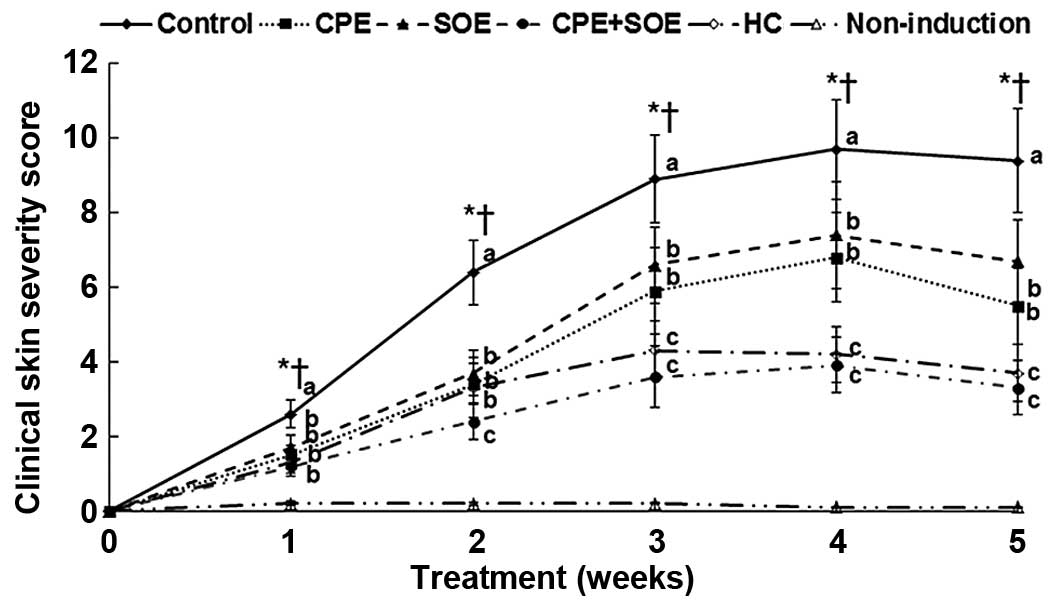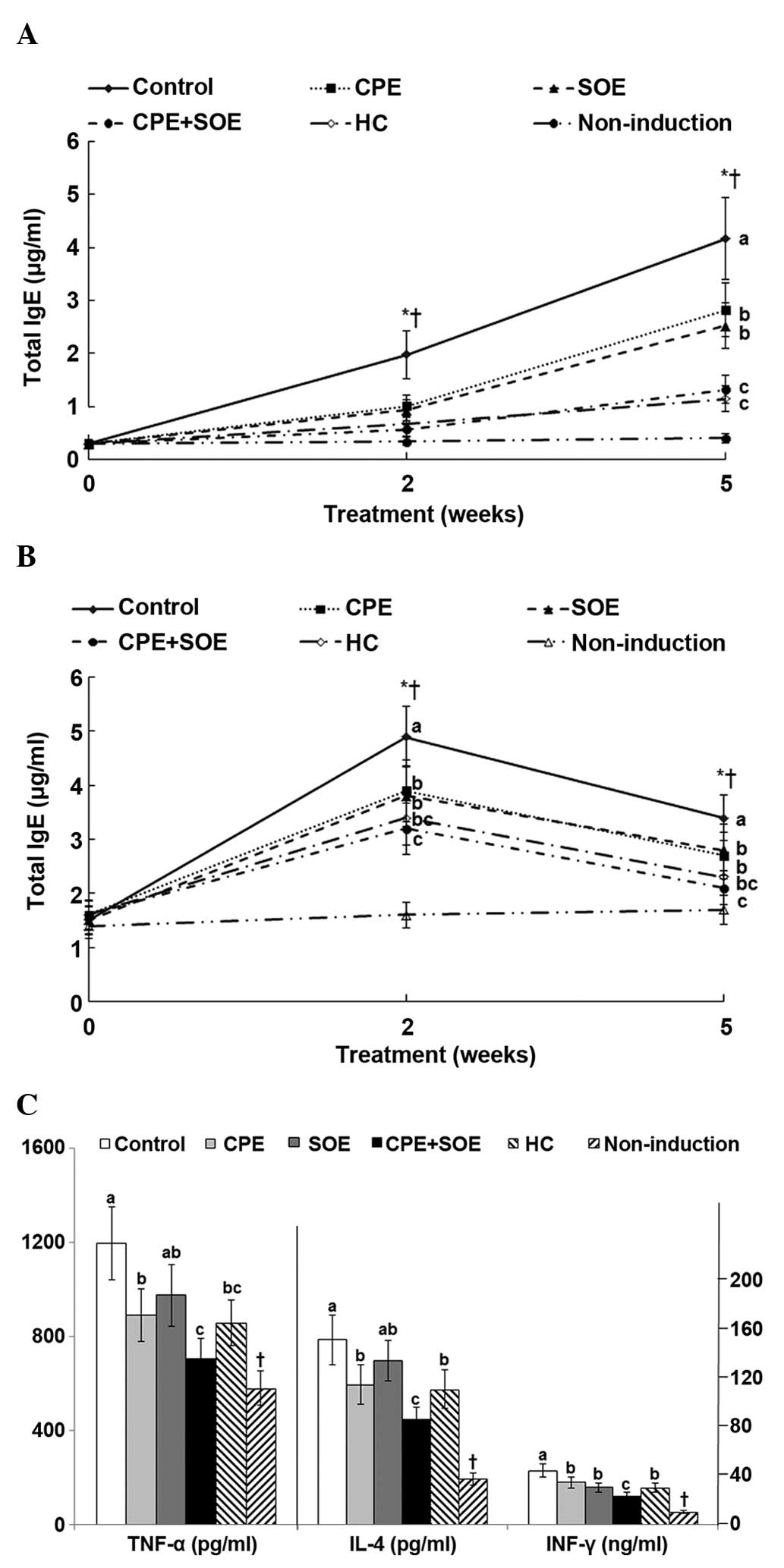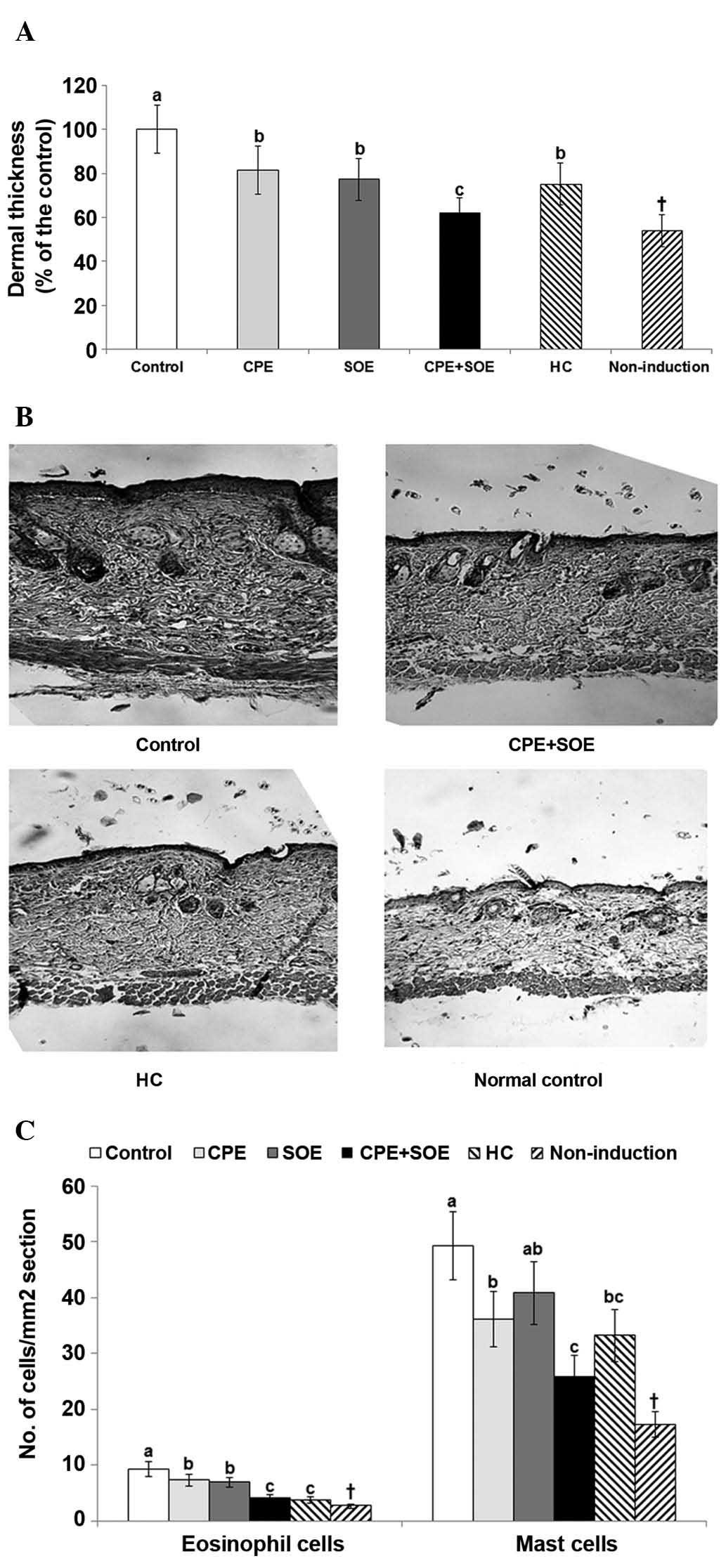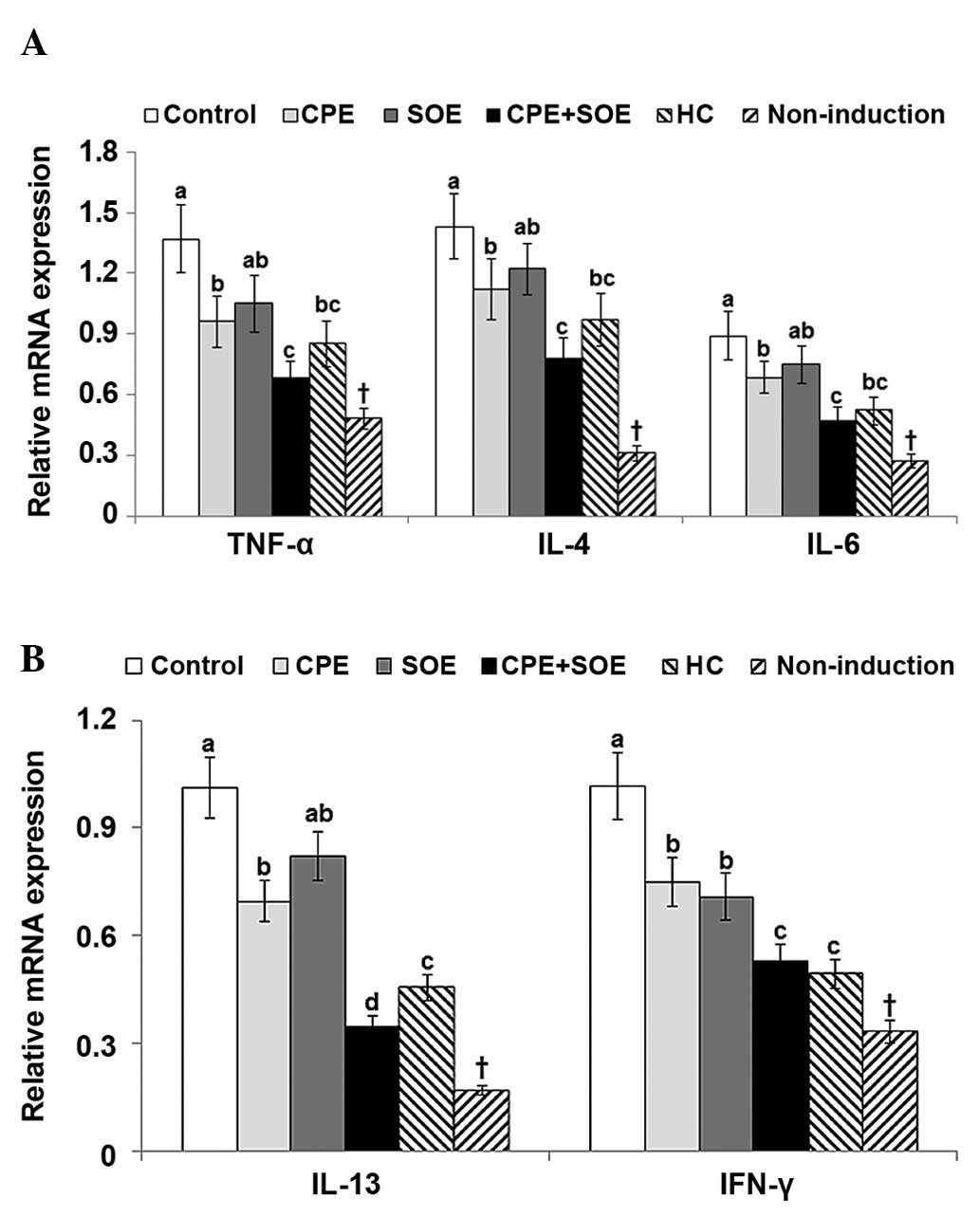|
1
|
Williams HC: Clinical practice. Atopic
dermatitis. N Engl J Med. 352:2314–2324. 2005. View Article : Google Scholar : PubMed/NCBI
|
|
2
|
Leung DYM: New insights into the complex
gene-environment interactions evolving into atopic dermatitis. J
Allergy Clin Immunol. 118:37–39. 2006. View Article : Google Scholar
|
|
3
|
Esparza-Gordillo J, Weidinger S,
Fölster-Holst R, Bauerfeind A, Ruschendorf F, Patone G, Rohde K,
Marenholz I, Schulz F, Kerscher T, et al: A common variant on
chromosome 11q13 is associated with atopic dermatitis. Nat Genet.
41:596–601. 2009. View
Article : Google Scholar : PubMed/NCBI
|
|
4
|
Bieber T: Atopic dermatitis. N Engl J Med.
358:1483–1494. 2008. View Article : Google Scholar : PubMed/NCBI
|
|
5
|
Leung AK and Barber KA: Managing childhood
atopic dermatitis. Adv Ther. 20:129–137. 2003. View Article : Google Scholar : PubMed/NCBI
|
|
6
|
Cork MJ, Robinson DA, Vasilopoulos Y,
Ferguson A, Moustafa M, MacGowan A, Duff GW, Ward SJ and
Tazi-Ahnini R: New perspectives on epidermal barrier dysfunction in
atopic dermatitis: Gene-environment interactions. J Allergy Clin
Immunol. 118:3–21. 2006. View Article : Google Scholar : PubMed/NCBI
|
|
7
|
Danby SG and Cork MJ: The effects of
pimecrolimus on the innate immune response in atopic dermatitis. Br
J Dermatol. 168:235–236. 2013. View Article : Google Scholar : PubMed/NCBI
|
|
8
|
Kim EC, Lee HS, Kim SK, Choi MS, Lee S,
Han JB, An HJ, Um JY, Kim HM, Lee NY, et al: The bark of Betula
platyphylla var.japonica inhibits the development of atopic
dermatitis-like skin lesions in NC/Nga mice. J Ethnopharmacol.
116:270–278. 2008. View Article : Google Scholar : PubMed/NCBI
|
|
9
|
Choi YY, Kim MH, Han JM, Hong J, Lee TH,
Kim SH and Yang WM: The anti-inflammatory potential of Cortex
Phellodendron in vivo and in vitro: Down-regulation of No and iNOS
through suppression of NF-κB and MAPK activation. Int
Immunopharmacol. 19:214–220. 2014. View Article : Google Scholar : PubMed/NCBI
|
|
10
|
Park S, Lee JB and Kang S: Topical
application of Chrysanthemum indicum L. Attenuates the development
of atopic dermatitis-like skin lesions by suppressing serum IgE
levels, IFN-γ and IL-4 in Nc/Nga mice. Evid Based Complement
Alternat Med. 2012:8219672012. View Article : Google Scholar
|
|
11
|
Xian YF, Mao QQ, Ip SP, Lin ZX and Che CT:
Comparison on the anti-inflammatory effect of cortex Phellodendri
chinensis and cortex Phellodendri amurensis in
12-O-tetradecanoyl-phorbol-13-acetate-induced ear edema in mice. J
Ethnopharmacol. 137:1425–1430. 2011. View Article : Google Scholar : PubMed/NCBI
|
|
12
|
Gong F, Shen Y, Zhang Q, Sun Y, Tang J,
Tao F and Xu Q: Obaculactone suppresses Th1 effector cell function
through down-regulation of T-bet and prolongs skin graft survival
in mice. Biochem Pharmacol. 80:218–225. 2010. View Article : Google Scholar : PubMed/NCBI
|
|
13
|
Zhang C: Determination of obacunone and
obaculactone in different processing products of Phellodendria
murensis cortex. Zhong Yao Cai. 36:205–208. 2013.In Chinese.
PubMed/NCBI
|
|
14
|
Cai Z, Li W, Wang H, Yan W, Zhou Y, Wang
G, Cui J and Wang F: Anti-tumor and immunomodulating activities of
a polysaccharide from the root of Sanguisorba officinalis L. Int J
Biol Macromol. 51:484–488. 2012. View Article : Google Scholar : PubMed/NCBI
|
|
15
|
Yu T, Lee YJ, Yang HM, Han S, Kim JH, Lee
Y, Kim C, Han MH, Kim MY, Lee J and Cho JY: Inhibitory effect of
Sanguisorba officinalis ethanol extract on NO and PGE2
production is mediated by suppression of NF-κB and AP-1 activation
signaling cascade. J Ethnopharmacol. 134:11–17. 2011. View Article : Google Scholar
|
|
16
|
Hayakawa R: Human closed patch test. Skin
Res. 26:1119–1127. 1984.In Japanese.
|
|
17
|
Zhishen J, Mengcheng T and Jianming W: The
determination of flavonoid contents in mulberry and their
scavenging effects on superoxide radicals. Food Chem. 64:555–559.
1999. View Article : Google Scholar
|
|
18
|
Rao TM, Rao BG and Rao YV: Antioxidant
activity of Spilanthes acmella extracts. Int J Phytopharmacol.
3:216–220. 2012.
|
|
19
|
Mills LB, Mordan LJ, Roth HL, Winger EE
and Epstein WL: Treatment of severe atopic dermatitis by topical
immune modulation using dinitrochlorobenzene. J Am Acad Dermatol.
42:687–689. 2000. View Article : Google Scholar : PubMed/NCBI
|
|
20
|
Kunz B, Oranje AP, Labrèze L, Stalder JF,
Ring J and Taïeb A: Clinical validation and guidelines for the
SCORAD index: Consensus report of the european task force on atopic
dermatitis. Dermatology. 195:10–19. 1997. View Article : Google Scholar : PubMed/NCBI
|
|
21
|
Ong PY and Leung DY: Immune dysregulation
in atopic dermatitis. Curr Allergy Asthma Rep. 6:384–389. 2006.
View Article : Google Scholar : PubMed/NCBI
|
|
22
|
Abramovits W: A clinician's paradigm in
the treatment of atopic dermatitis. J Am Acad Dermatol. 53(1 Suppl
1): S70–S77. 2005. View Article : Google Scholar : PubMed/NCBI
|
|
23
|
Livak KJ and Schmittgen TD: Analysis of
relative gene expression data using real-time quantitative PCR and
the 2(−Delta Delta C(T)) Method. Methods. 25:402–408. 2001.
View Article : Google Scholar
|
|
24
|
Matsuda H, Watanabe N, Geba GP, Sperl J,
Tsudzuki M, Hiroi J, Matsumoto M, Ushio H, Saito S, Askenase PW and
Ra C: Development of atopic dermatitis-like skin lesion with IgE
hyperproduction in NC/Nga mice. Int Immunol. 9:461–466. 1997.
View Article : Google Scholar : PubMed/NCBI
|
|
25
|
Takahashi N, Arai I, Honma Y, Hashimoto Y,
Harada M, Futaki N, Sugimoto M and Nakaike S: Scratching behavior
in spontaneous- or allergic contact-induced dermatitis in NC/Nga
mice. Exp Dermatol. 14:830–837. 2005. View Article : Google Scholar : PubMed/NCBI
|
|
26
|
Hashimoto Y, Takaoka A, Sugimoto M, Honma
Y, Sakurai T, Futaki N and Arai I: Itch-associated scratching
contributes to the development of dermatitis and
hyperimmunoglobulinaemia E in NC/Nga mice. Exp Dermatol.
20:820–825. 2011. View Article : Google Scholar : PubMed/NCBI
|
|
27
|
Vailes LD, Perzanowski MS, Wheatley LM,
Platts-Mills TA and Chapman MD: IgE and IgG antibody responses to
recombinant Alt a 1 as a marker of sensitization to alternaria in
asthma and atopic dermatitis. Clin Exp Allergy. 31:1891–1895. 2001.
View Article : Google Scholar : PubMed/NCBI
|
|
28
|
Galli SJ and Tsai M: IgE and mast cells in
allergic disease. Nat Med. 18:693–704. 2012. View Article : Google Scholar : PubMed/NCBI
|
|
29
|
Grewe M, Bruijnzeel-Koomen CA, Schöpf E,
Thepen T, Langeveld-Wildschut AG, Ruzicka T and Krutmann J: A role
for Th1 and Th2 cells in the immunopathogenesis of atopic
dermatitis. Immunol Today. 19:359–361. 1998. View Article : Google Scholar : PubMed/NCBI
|
|
30
|
Chen L, Martinez O, Overbergh L, Mathieu
C, Prabhakar BS and Chan LS: Early up-regulation of Th2 cytokines
and late surge of Th1 cytokines in an atopic dermatitis model. Clin
Exp Immunol. 138:375–387. 2004. View Article : Google Scholar : PubMed/NCBI
|
|
31
|
Yamanaka K and Mizutani H: The role of
cytokines/chemokines in the pathogenesis of atopic dermatitis. Curr
Probl Dermatol. 41:80–92. 2011. View Article : Google Scholar : PubMed/NCBI
|













